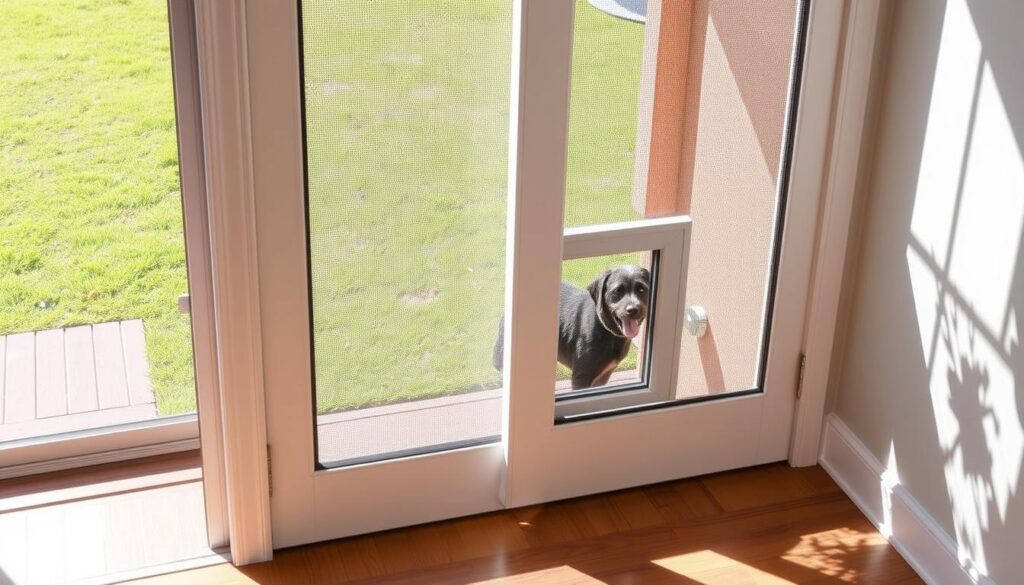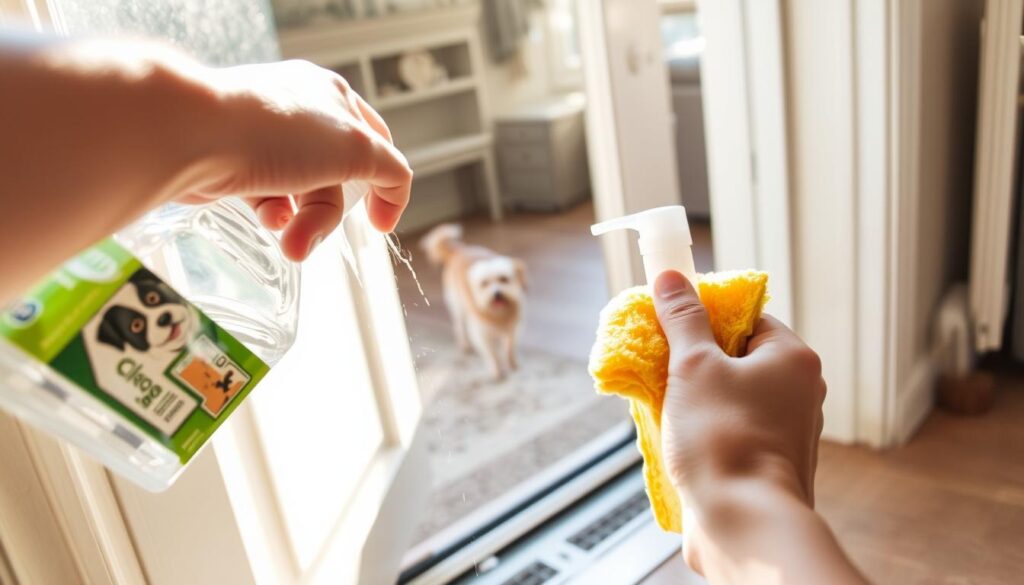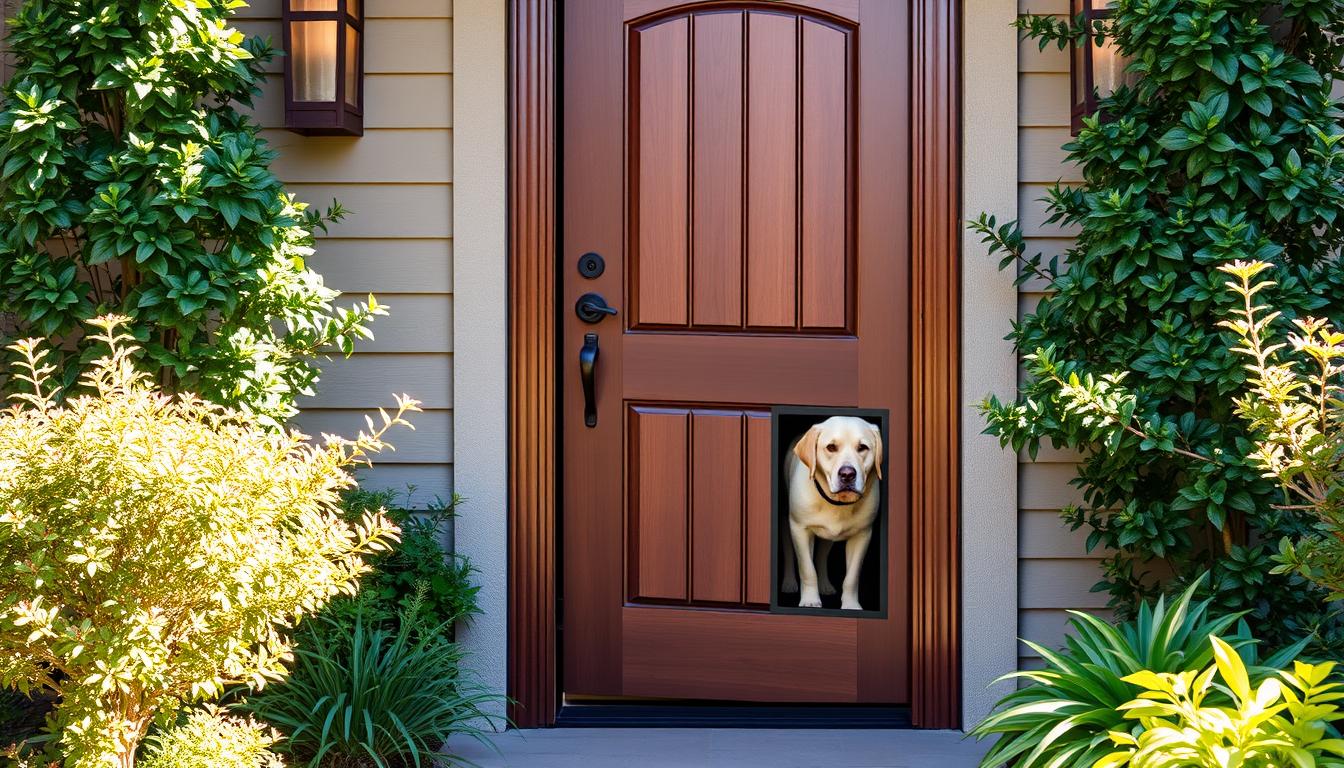As a pet owner, you know how important it is for your dog to have easy access outside. A door with a built-in dog door can change your home life for the better. It offers a smooth solution for you and your pet. These integrated door systems have become very popular in recent years.
These doors with dog doors come with many benefits. They give your pet more freedom, save energy, and improve your home’s security. They are designed to make life better for both you and your pet.
Key Takeaways
- Discover the convenience of doors with built-in dog doors
- Explore the growing popularity of these integrated solutions
- Understand the various benefits for pet owners and homeowners
- Learn about the different types of dog doors available on the market
- Discover essential measurements and considerations for installation
Understanding the Benefits of Installing a Door with Dog Door
Homeowners looking to better their pets’ lives and save energy might think about a door with a dog door. This smart feature brings many advantages for pets and their owners.
Enhanced Pet Independence
A door with a dog door lets pets move freely. They can go outside, play, and use the bathroom without always needing a human. This freedom makes them happier and healthier.
Energy Conservation Features
Doors with dog doors are designed to save energy. They have insulation and weatherstripping to keep the inside climate steady. This helps cut down on energy use and lowers bills, which is good for the planet.
Improved Home Security
Many think a door with a dog door is a security risk. But, modern ones have locks and special flaps to keep intruders out. This keeps your home safe even when your pet is outside.
In summary, a door with a dog door is great for pets, saves energy, and boosts home security. It’s a smart choice for any home with pets.
Types of Dog Doors Available in the Market
There are many dog doors available to let your dog go outside easily. These doors fit different pet sizes, home types, and personal tastes. They can change your home and give your dog more freedom.
Flap Dog Doors
Flap dog doors are a favorite among pet owners. They have a hinged flap that lets your dog go in and out easily. You can choose from vinyl, plastic, or insulated options for a good fit.
Electronic Dog Doors
Electronic dog doors are high-tech. They have sensors that open and close the door for your dog. Some even let you control the door from a distance.
Sliding Panel Dog Doors
Sliding panel dog doors are versatile. They fit into standard doors and dog screen doors. Your dog can slide through for easy access. They’re great for those who like a simple look.
| Dog Door Type | Key Features | Ideal For |
|---|---|---|
| Flap Dog Doors |
| Versatile for most home setups and pet sizes |
| Electronic Dog Doors |
| Homes with tech-savvy owners and active pets |
| Sliding Panel Dog Doors |
| Homeowners seeking a modern, integrated solution |
No matter your needs, there’s a wide range of dog doors for doors out there. They ensure your dog can enjoy freedom and independence.
Essential Measurements for Dog Door Installation
Choosing the right dog door for your home is more than picking a style. It’s about making sure it fits well for your dog’s comfort and safety. We’ll look at key measurements to consider when picking and installing a dog and door solution.
Pet Size Considerations
The size of your dog is key in picking the right dog door size. Measure your dog’s height at the shoulder and its widest width. This ensures your dog can move through easily, without getting stuck or hurt.
Door Frame Requirements
The dog door must fit well in your door frame. Measure your door’s thickness and the space available for width and height. This helps pick a dog and door that installs right, without harming your home’s structure.
Height and Width Guidelines
- The dog door should be 2 inches taller than your pet’s shoulder height.
- It should be wide enough for your pet’s widest point, plus 2-4 inches on each side for comfort.
- The bottom of the dog door should be 4-6 inches off the floor for easy access.
By thinking about these key measurements, you can find the perfect dog door for your home and dog.
| Dog Size | Recommended Door Height | Recommended Door Width |
|---|---|---|
| Small (up to 20 lbs) | 8-10 inches | 9-11 inches |
| Medium (21-50 lbs) | 11-14 inches | 12-16 inches |
| Large (51-100 lbs) | 15-18 inches | 16-20 inches |
| Extra-Large (over 100 lbs) | 19-24 inches | 20-24 inches |
Remember, these are just guidelines. It’s crucial to measure your pet for the best fit and comfort.
Popular Materials Used in Dog Door Construction
Choosing the right material for your dog door is key. You have options like lightweight plastics, rustproof aluminum, and weather-resistant vinyl. Each has its own benefits to fit your needs. Let’s look at the most common materials for dog screen doors and doors.
Plastic Doggie Doors
Plastic is a top pick for dog doors because it’s affordable and easy to install. They’re made from strong polycarbonate or ABS, keeping them safe from damage. Plus, they help keep your home warm or cool, saving on energy costs.
There are also plastic dog screen door options. These fit right into your screen door, making it easy to add a dog door.
Aluminum Doggie Doors
Aluminum doggie doors are great for those who want something durable and lasting. Aluminum is tough, doesn’t rust, and stands up to the weather. It’s perfect for homes in tough climates or where there’s a lot of foot traffic.
Vinyl Doggie Doors
Vinyl doggie doors are flexible, keep the cold out, and look good. They’re made from top-quality vinyl, offering a weatherproof seal. Vinyl dog screen door options are great for homes with screen doors, blending in seamlessly.
| Material | Durability | Insulation | Aesthetic |
|---|---|---|---|
| Plastic | Good | Excellent | Basic |
| Aluminum | Excellent | Good | Moderate |
| Vinyl | Good | Very Good | Excellent |
When picking a material for your doggie doors or dog screen door, think about your pet, the weather, and your style. With so many choices, you’ll find the perfect fit for your home.
Electronic vs. Manual Dog Doors: Making the Right Choice
Homeowners face a big decision when choosing between electronic and manual dog doors. Each type has its own set of features and benefits. Let’s explore the differences between smart door technologies and traditional flap systems to find the best option for you and your pet.
Smart Door Technologies
Electronic dog doors, or smart dog doors, use advanced tech for easy and secure pet entry. They come with sensors that open the door when your dog approaches. Some even connect to your smart home, letting you control access from your phone or voice assistant.
These doors offer better security. You can set them to lock or limit access as you wish.
Traditional Flap Systems
Manual dog doors work with a simple flap that lets your pet go in and out. They’re cheaper than electronic doors and don’t need power or tech. But, they don’t have the security features or remote control of smart doors.
Security Features Comparison
| Feature | Electronic Dog Doors | Manual Dog Doors |
|---|---|---|
| Remote Access | Allows for remote locking and monitoring | No remote access capabilities |
| Pet Restrictions | Can be programmed to restrict access based on pet size or identity | No advanced pet identification or restriction features |
| Weatherproofing | Often feature advanced weatherproofing to prevent drafts and energy loss | Rely on the quality of the manual flap to provide weatherproofing |
The choice between electronic and manual dog doors depends on your needs and preferences. Think about security, convenience, and energy efficiency to pick the right one for your home and pet.
Installation Guide for Screen Door with Dog Door
Adding a dog door to your screen door is a smart move for pet owners. It’s a cost-effective way to let your pet in and out. This guide will help you, whether you’re doing it yourself or hiring a pro.
Necessary Tools and Preparation
First, make sure you have these tools ready:
- Tape measure
- Pencil or marker
- Drill and drill bits
- Jigsaw or utility knife
- Scissors
- Screwdriver
- Hammer
Measure your screen door and compare it to the dog door. Mark where the dog screen door will go. Think about your pet’s height and where you want it.
DIY Installation
For a DIY job, just follow these steps:
- Use a jigsaw or utility knife to cut the screen door. Follow your marks carefully.
- Put the dog door frame in the hole, making sure it fits well.
- Use screws or adhesive to secure the frame, as the product says.
- Attach the flap or electronic part to the frame and test it.
- Cut off any extra screen around the dog door frame.
Professional Installation
If you’d rather have a pro do it, call a local home improvement or pet store. They can install your screen door with dog door right.

Getting it installed right is key for your home’s safety and your pet’s comfort. Follow this guide to add a dog screen door without harming your screen door.
Weather-Resistant Dog Doors for Extreme Conditions
Weather-resistant dog doors are a big help for your dog’s comfort and your home’s energy use. They are made to handle tough weather, letting your dog move freely while keeping your home just right.
Insulation Properties
These doors are special because they keep the heat in and the cold out. They use top-notch materials to block heat transfer. This makes your dog cozy and helps save energy, cutting down on your bills and carbon footprint.
Weatherproofing Features
Weatherproofing is key for these dog doors. They have advanced seals and strong builds to stop air and water leaks. No matter the weather, these doors keep your home safe and comfy.
Getting a weather-resistant dog door is a wise move for pet owners in harsh weather areas. They offer great insulation and weatherproofing. This means your dog has easy access and your home stays cozy and energy-efficient.
| Feature | Benefit |
|---|---|
| Robust Insulation | Maintains indoor temperature, reducing energy costs |
| Weatherproofing | Protects against rain, wind, and snow, ensuring a secure and comfortable environment |
| Durable Construction | Withstands the rigors of extreme weather conditions, minimizing the need for frequent replacements |
Maintaining and Cleaning Your Dog Door
Keeping your dog door in good shape is key for its long life and best performance. Regular care and cleaning help your pet get in and out easily. It also keeps your home safe and comfortable. Here are the main steps to keep your dog doors for doors clean and working well.
Routine Maintenance Checklist
- Check the hinges, flap, and frame for wear or damage.
- Oil the hinges and other moving parts for smooth action.
- Look at the seals to stop air leaks and drafts.
- Clean the flap and around it to remove dirt and pet hair.
- Make sure the lock works right, if your door has one.
Cleaning Methods and Supplies
For cleaning your dog door, use safe, gentle cleaners. Stay away from strong chemicals that could hurt your pet or damage the door. Use a soft soap and water mix or a dog door cleaner. Wipe the flap, frame, and other parts you can reach, but don’t get water in the door’s parts.
“Keeping your dog door clean and working is key for your pet’s safety and your home’s energy use.”
Regular cleaning and care make your dog door look great and work well for a long time.

By doing these easy steps, you keep your dog door in top shape. It lets your pet in and out easily while keeping your home safe and cozy.
Safety Features in Modern Dog Doors
Dog owners want their pets to have more freedom and ease. Modern dog doors now come with advanced safety features. These features boost home security and keep pets safe.
Lock Mechanisms
Modern dog doors have secure lock mechanisms. These locks let homeowners control who comes in. They keep pets safe while keeping unwanted visitors out.
There are different types of locks, like automatic and manual deadbolts. These options give homeowners peace of mind and protect their homes and pets.
Pet Recognition Systems
Modern dog doors also have pet recognition systems. These systems use sensors or RFID chips to know which pets can enter. This keeps the home safe from other animals.
It also stops any fights or accidents that might happen with other pets or wildlife.

